At a glance . . .
custName -> custNo
model -> make
outletLoc -> outletNo
carReg, custNo -> hireDate
carReg, custName -> hireDate
And I'm sure there are others. The sample data isn't representative, and that's a problem when you try to determine functional dependencies from data. Let's say your sample data had only one row.
carReg hireDate make model custNo custName outletNo outletLoc
--
MS34 0GD 14/5/03 Ford Focus C100 Smith, J 01 Bearsden
FDs answer the question, "Given one value for 'x', do I know one and only one value for 'y'?" Based on that one-row set of sample data, every attribute determines every other attribute. custNo determines hireDate. hireDate determines outletLoc. custName determines model.
When sample data isn't representative, it's easy to turn up FDs that aren't valid. You need more representative sample data to weed out some invalid functional dependencies.
custName -> custNo isn't valid ('C101', 'Hen, P')
carReg, custNo -> hireDate isn't valid ('MS34 0GD', 'C100', '15/7/04')
carReg, custName -> hireDate isn't valid ('MS34 0GD', 'Hen, P', '15/8/03')
You can investigate functional dependencies in sample data by using SQL.
create table reg (
CarReg char(8) not null,
hireDate date not null,
Make varchar(10) not null,
model varchar(10) not null,
custNo char(4) not null,
custName varchar(10) not null,
outletNo char(2) not null,
outletLoc varchar(15) not null
);
insert into reg values
('MS34 OGD', '2003-05-14', 'Ford', 'Focus', 'C100', 'Smith, J', '01', 'Bearsden'),
('MS34 OGD', '2003-05-15', 'Ford', 'Focus', 'C201', 'Hen, P', '01', 'Bearsden'),
('NS34 TPR', '2003-05-16', 'Nissan', 'Sunny', 'C100', 'Smith, J', '01', 'Bearsden'),
('MH34 BRP', '2003-05-14', 'Ford', 'Ka', 'C313', 'Blatt, O', '02', 'Kelvinbridge'),
('MH34 BRP', '2003-05-20', 'Ford', 'Ka', 'C100', 'Smith, J', '02', 'Kelvinbridge'),
('MD51 OPQ', '2003-05-20', 'Nissan', 'Sunny', 'C295', 'Pen, T', '02', 'Kelvinbridge');
Does model determine make?
select distinct model
from reg
order by model;
model
--
Focus
Ka
Sunny
Three distinct models . . .
select model, make
from reg
group by model, make
order by model;
model make
--
Focus Ford
Ka Ford
Sunny Nissan
Yup. One make for each model. Based on the sample data, model -> make.
Does carReg, custName -> hireDate?
select distinct carReg, custName
from reg
order by custName;
carReg
--
MH34 BRP Blatt, O
MS34 OGD Hen, P
MD51 OPQ Pen, T
MS34 OGD Smith, J
NS34 TPR Smith, J
MH34 BRP Smith, J
Six distinct combinations of carReg and custName.
select carReg, custName, hireDate
from reg
group by carReg, custName, hireDate
order by custName;
carReg custName hireDate
--
MH34 BRP Blatt, O 2003-05-14
MS34 OGD Hen, P 2003-05-15
MD51 OPQ Pen, T 2003-05-20
MH34 BRP Smith, J 2003-05-20
NS34 TPR Smith, J 2003-05-16
MS34 OGD Smith, J 2003-05-14
Yup. One hireDate for each combination of carReg and custName. So based on the sample data, {carReg, custName} -> hireDate.

